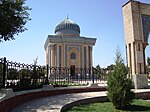Tafsir al-Maturidi
This article needs additional citations for verification. (October 2020) |
 | |
| Editor | Ahmet Vanlıoğlu |
|---|---|
| Author | Abu Mansur al-Maturidi |
| Original title | Ta'wilat al-Qur'an (also Ta'wilat Ahl al-Sunna)[1] |
| Translator | Translated into Turkish by Bekir Topaloğlu, Mehmet Erdoğan, İbrahim Tüfekçi, S. Kemal Sandıkçı, Fadıl Ayğan, Yunus Vehbi Yavuz |
| Cover artist | Halil Yılmaz |
| Country | Ma Wara' al-Nahr (the land which lies beyond the river), Transoxiana (Central Asia) |
| Language | Arabic, Turkish |
| Subject | Tafsir |
| Publisher | Mizan Yayınevi, Ensar Neşriyat |
| Followed by | Kitab al-Tawhid |
Ta'wilat Ahl al-Sunnah (Arabic: تأويلات أهل السنة, lit. 'Interpretations of the People of the Sunnah') or Ta'wilat al-Qur'an (Arabic: تأويلات القرآن, lit. 'Interpretations of the Qur'an'), better known as Tafsir al-Maturidi (Arabic: تفسير الماتريدي), is a classical Sunni tafsir (Qur'anic exegesis), written by the Hanafi scholar Abu Mansur al-Maturidi (d. 333/944), who was a contemporary of al-Tabari.[2][3][4][5]
Al-Maturidi prefers to combine the traditional and rational sources. Consequently, it can be identified as the exegesis that amalgamates traditional exegesis (Tafsir bi al-Ma'thur — which is interpretation based on tradition or text) with rational exegesis (Tafsir bi al-Ra'y — which is exegesis based on independent opinion).[6]
Al-Maturidi often indicates what the theological or sectarian issues at stake in debates over the meanings of a given verse or passage of scripture. He defended wisely, reasonably and strongly the doctrinal views of Ahl al-Sunnah wa al-Jama'ah on the valid basis available in the Qur'an.[7]
According to a later commentator on this work, 'Alā' al-Din Ahmad b. Muhammad Abu Bakr al-Samarqandi (d. around 540/1145), al-Maturidi did not write the Ta'wilat himself; rather, it is a compilation of his teachings that was prepared by his students. This is possible, as in some parts of the text the line of argument is rather convoluted and repetitious and does not appear to have been composed by a single author.[8]
See also[edit]
References[edit]
- ^ Issa J. Boullata, ed. (2000). Literary Structures of Religious Meaning in the Qu'ran. Curzon Press. p. 73. ISBN 9780700712564.
- ^ Qahtan 'Abd al-Rahman al-Duri (January 2016). Al-'Aqidah al-Islamiyyah wa Madhahibuha (in Arabic). Dar Al Kotob Al Ilmiyah دار الكتب العلمية. ISBN 9782745171962 – via Google Books.
- ^ Magdy Za'bal, ed. (January 2010). Al-Hiwar al-'Arabi al-Turki Hawla Qadaya al-Islam fi Asya al-Wusta (in Arabic). Al Manhal. ISBN 9796500166018 – via Google Books.
- ^ "Te'vîlâtül Kur'ân Tercümesi 1". Siyer Yayınları (in Turkish). Ensar Neşriyat.
- ^ Murtada al-Zabidi (January 2016). "Ithaf al-Sada al-Muttaqin". Google Books (in Arabic).
- ^ Ahmad Choirul Rofiq (2009). "The Methodology of al-Maturidi's Qur'anic Exegesis: Study of Ta'wilat Ahl al-Sunnah". Al-Jami'ah: Journal of Islamic Studies. 47 (2). Al-Qalam Journal: 317–342. doi:10.14421/ajis.2009.472.317-342.
- ^ Dr. Israr Ahmed Khan. "العلامة أبو منصور الماتريدي ومنهج تفسيره". aljamiah.or.id. Al-Jami'ah Journal of Islamic Studies.
- ^ Aisha Geissinger (2015). Gender and Muslim Constructions of Exegetical Authority: A Rereading of the Classical Genre of Qur'an Commentary. Brill Academic Publishers. pp. 21–22. ISBN 9789004294448.
External links[edit]
- Tafsir al-Maturidi - Altafsir.com (in Arabic)
- Tafsir al-Maturidi on Surat al-Qadr (English translation) — Institute for the Revival of Traditional Islamic Sciences (IRTIS)
- TE’VÎLÂTÜ’l-KUR’ÂN — İslâm Ansiklopedisi (in Turkish)

